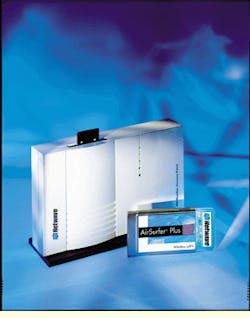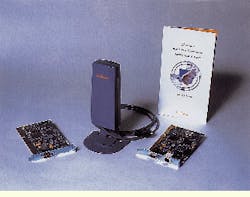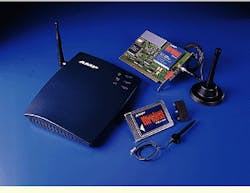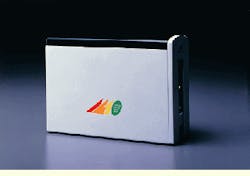Speed, bandwidth, and range are three issues to consider when choosing a wireless lan.
Daniel Sweeney
With possibly as many as 50 manufacturers worldwide now offering wireless local area network (lan) equipment, wireless in-building and interbuilding networking has assumed the appearance of a technology ground swell. And if for no other reason than the sheer level of manufacturing activity, this aspect of wireless computer networking should command at least a certain measure of attention on the part of any diligent mis manager or cabling contractor.
At the same time, it cannot be denied that wireless lans represent a market and a technology that are not yet mature. Moreover, due both to the multiplicity of approaches and the lack of interoperability in equipment from different vendors, selecting wireless lan products for use within an enterprise system is not a trivial undertaking.
With current equipment offerings numbering in the hundreds, it would be difficult to offer detailed product comparisons or even comprehensive discussions of key technology issues. Nevertheless, the principal classes of systems can be enumerated and defined and their usefulness within various applications can be elucidated.
Toward an overview
As is the case with the related category of the wireless private branch exchange (pbx), the nomenclature for the wireless lan is somewhat misleading. In fact very few lans dispense with hardwire connections entirely, and the majority of so-called wireless lans are properly hybrids. In most cases the wireless connection will only be broken at one point, most commonly between the backbone and the client terminal. Generally the backbone itself uses conventional copper cabling and terminations.
In terms of both functionality and features, wireless lans can be broken down into three main categories: bridges, integrated handheld implementations, and in-building wireless connectivity solutions for desktops and laptops. Only the last will be covered in detail here, but for purposes of an overview, and to provide a context for individual products within the overall system architecture, all three are briefly described.
Wireless bridges
The first category, that of the wireless bridge, may be defined as a wireless connection between two geographically separated networks or subnetworks. Usually the bridge consists of a point-to-point connection from building to building within a campus environment, but it can also be point-to-multipoint within an extended geographical area. Most wireless bridges operate over ranges not exceeding a few hundred yards, but products are available that can transmit in excess of 25 miles, linking offices across an entire metropolitan area or industrial region.
Bridges may operate over unlicensed industrial, scientific, and medical (ism) radio frequencies (rf) or licensed microwave radio frequencies, or may use infrared light, either coherent (laser) or incoherent. Most bridges in fact operate at 2.4 or 5.7 GHz unlicensed. Licensed microwave and laser (which does not require a license) both offer very high capacity and throughput, but at correspondingly high prices. An interesting new development here is the opening of the unlicensed 24-GHz band, which will allow for very high throughput--up to 10 megabits per second--without the attendant difficulties and expenses of licensed operation. High throughput at relatively low equipment expenditure is also provided by the sole example of an incoherent infrared light bridge--Silcom`s (Mississauga, ON, Canada) 10-Mbit/sec FreeBird--though the latter lacks the half-mile range of the 24-GHz radio bridges.
Handheld products
The next category, that of integrated handheld wireless lan products, consists of ruggedized terminals with limited computing functions and built-in radio modems--all of which operate in the unlicensed bands. The principal manufacturers of these are Symbol (Holtsville, NY), Telxon (Akron, OH), Norand (Cedar Rapids, IA), and Intermec (Everett, WA), with Symbol and Telxon accounting for most of the business. Such products find their homes chiefly on retail floors and in warehouses where they are used to perform point-of-purchase and inventory functions. The wireless cash register, currently manufactured by ibm, Veraphone, and National Cash Register, constitutes a closely related class of products.
All of the integrated devices mentioned are application-specific. As such they are ordinarily not components of a full-enterprise system.
The wireless link
The last class of products, wireless linkages for ordinary desktop or laptop computers, are intended to be transparent to the user and capable of fully supporting the common operating and networking systems used throughout the enterprise without the necessity of any intervening middleware or special discrete wireless platforms. Unlike wireless networks based upon public networks, such wireless lans require no dial-up and incur no air-time charges. Thus computers connected to a wireless lan can feasibly be permitted to operate on a continual basis. Nonetheless, it should not be assumed that the wireless connection is functionally equivalent to copper wire or glass fiber.
Anatomy of the wireless lan
Wireless lans are properly adjuncts to an existing wireline lan, whether an Ethernet or Token Ring type running over dedicated cabling, or an intranet or virtual private network using twisted-pair dial-up telephone connections. In physical terms the adjunct consists of two principal components: transceivers known as access points, which are hubs serving a number of terminals and wired back to a central router, and the somewhat inaccurately designated network interface cards (nics), which are corresponding transceivers for the individual stations, and which usually take the form of plug-in cards. Such cards may be of either the industry standard architecture (isa) type, in the case of desktop computers, or pcmcia cards in instances where the stations consist of laptop and palmtop computers. pcmcia implementations are probably more common if only because laptops are more apt to be used where mobility and hence, wireless connectivity, are desired.
As indicated, a wired backbone is generally present in wireless lans connecting the access points back to a router, which serves as a gateway to the wired portion of the enterprise system. But at least one product, the Wilan Hopper Hub, has a provision for wireless connectivity between access points themselves as well as between access points and individual stations. In situations where work-area logistics do not permit any wires to be run, such a provision would be of critical importance.
Due to the low permissible transmitting power and consequent limited range of the transceivers, wireless lans generally conform to a cellular architecture where multiple access points are provided, and hand-offs from access point to access point, and hence from cell to cell, are managed automatically by the system. Network management functions are ordinarily implemented in software resident in the server, which itself functions as a sort of central office. Standalone switches are not the norm in these types of networks.
Some systems, such as the Netwave (Pleasanton, CA) AirSurfer and the Lucent Technologies (Parsippany, NJ) products equipped with Netware 4 server support software, allow for peer-to-peer connectivity through direct radio connections from station to station without the intervention of an access point. Nevertheless, due to the limited range of the transceivers, which is itself a function of Federal Communications Commission-mandated power caps and the cellular architecture of most of the systems, direct peer-to-peer radio communications are not possible over an extended network or with an extensive number of users. Normally, if another station in the network is to be contacted, an outgoing signal from the first station goes up to an access point and into the wireline backbone and then to another access point before finally reaching the second station. Thus, in a sense, the access points and nics constitute miniature bridges providing the last link in a signal chain.
With few exceptions, wireless lans offer full mobility, that is, a station may be moved from cell to cell without re-registering the node to the network. In many systems a hand-off can occur while the station is in motion.
The trend in the design of both client interfaces and access points is toward compact form factors. Most access points made today are unobtrusive wall- or ceiling-mount modules weighing at most a few pounds, while the majority of station interfaces are card-based; however, most of the latter will incorporate antenna mountings that protrude some distance from the chassis of the computing device. pcmcia cards will normally run off batteries to permit untethered use of the computer, and operating times are comparable to those of the portables themselves--two to four hours between recharges.
Unfortunately, there is, in current product offerings, a direct correlation between size and throughput speed. The most capable performers among the wireless lan interfaces also tend to be the largest as well as the most expensive.
Medium of transmission
In-building wireless lans use one of three media for broadcasting data without conventional wires: radio waves, infrared light or powerline carriers. Our concentration here is on rf lans, while the infrared variety, which offers a number of advantages and one significant liability, is given separate consideration (see "Infrared lans").
RF in-building lans operate primarily within the 902- to 928-megahertz ism band and the newer 2.4-GHz ism band. Products are just now coming out that will operate within the even newer 5.7-GHz band. Unique among current product offerings is the Windata (Littleton, MA) FreePort in-building system, which uses both the 900-MHz and 2.4-GHz bands for higher total bandwidth. In the not-too-distant future we will see products designed to operate at 5.2 and 5.3 GHz as well.
The feeling today among industry analysts is that 900-MHz technology is on the way out, and certainly relatively little equipment operates there any longer. Most systems today broadcast at 2.4 GHz, though the frequencies above 5 GHz are attractive due to the greater bandwidth allocations. Nevertheless, a complete migration to higher bands is unlikely because higher-frequency transmissions have difficulty penetrating walls.
System fit
No wireless lan product is truly universal in the sense that a hardwire connection is. In other words, the wireless connection is not an empty pipe for the transmission of data. Radio modems must, of necessity, reformat data to be transmitted according to their own internal protocols, and therefore congruity must exist between those wireless protocols and the wireline networking protocols.
In practical terms this means that wireless lans will support some but not all networking standards. Most popular wireless lans support multiple selected protocols, such as Novell Netware, Banyan Vines, and Windows NT, to name some of the more popular, but relatively few support AppleTalk. Lucent Wavelan and the Digital Ocean (Lenexa, KS) and otc (San Jose, CA) products are among the handful that do.
Speed
Wireless lans are, for the most part, slower than their wireline counterparts running over coaxial cable. Claimed speeds for most products on the market are in the 1- to 2-Mbit/sec range, but those are best-case figures assuming short-range transmissions over lightly loaded networks where interference is at a minimum. Says Craig Mathias of the Far Point Group, a noted consultant in the field, "De-rate the system 50% to 60% and you`ll be a lot closer to the real-world performance." In other words, despite the fact that most of these products come with 10BaseT-Ethernet connections to the server, very few operate at Ethernet speeds.
Currently, Radiolan (Sunnyvale, CA) is shipping a 10-Mbit/sec product, the Wireless Interface Node and Wireless Access Point Model 10A. These devices use a proprietary modulation scheme but one that does not rely on spread-spectrum techniques. In addition, Lucent Technologies` Bell Laboratories recently announced pulse position modulation technology, which will permit 10-Mbit/sec transmissions. The 10-Mbit/sec products are not yet available; the Lucent Wavelan products currently shipping provide 2-Mbit/sec performance.
Windata`s FreePort system, which transmits over both 900-MHz and 2.4-GHz bands, is currently available and boasts 5.7-Mbit/sec transmission.
Most wireless lans are disadvantaged vis `a vis Ethernets. On the other hand, a network running over ordinary unconditioned public phone lines will transmit much more slowly, at 56 kilobits per second max, while Integrated Services Digital Network will only better that by a factor of two. Higher speeds over public network connections can only be had by means of digital subscriber line technology for telephone twisted-pair cable, which is just now becoming available in a handful of markets, or with cable modems feeding off cable-television networks--also a new technology that is unavailable in most places. And a leased T1 line, the usual resort of organizations with physically separated facilities and data-intensive operations, will only achieve a 1.554-Mbit/sec throughput rate--on a rough parity with most wireless lans, and typically at a cost of hundreds of dollars per line per month.
Still, there seems little question that the price of high-speed data linkages offered by public carriers will continue to drop, and that such services will eventually become ubiquitous. Already cable modems operating at several megabits per second are being leased to businesses at basic rates in the $50-per-month range in selected markets, and Hughes has announced an ultra-high-capacity two-way satellite service called SpaceNet scheduled for launch within the next two years. In the future, wireless lan manufacturers will not only be competing with unconditioned twisted pair and T1. They must also contend with fundamentally new delivery systems that are significantly faster than either.
Facing the challenge
Given the constraints of bandwidth, can the throughput of wireless lans be elevated to compete with those of the emerging data services?
Fast Ethernet speeds (100 Mbits/sec) do not appear to be in the offing over the unlicensed bands currently used in almost all in-building systems. But unless fiber-to-the-curb becomes a reality among telephone carriers or cable-television operators--an eventuality which few analysts predict any time soon--such speeds will not be offered over public networks either. The short-term action will be Ethernet-level--10 Mbits/sec max, though achieving such speeds with twisted-pair copper is not doable with any commercially available technology, and it`s difficult over the hybrid-fiber networks used by cable operators.
It isn`t easy over ism bands either, as evidenced by the existence of but two products today, but you are unlikely to remain alone in this area for long simply because other advanced modulation techniques are available for increasing throughput over limited bandwidth.
Regarding range
In regard to the range of RF in-building lans, maxima are a bit hard to establish because performance degrades gradually over distance. Manufacturer claims range from 150 to 500 feet to twice that distance outside. Range considerations are significant in arriving at the number and location of access points in the system. But an equally important determinant there is channel capacity, which delimits the amount of traffic one access point can handle. Typically systems in the 2.4-GHz region have 15 channels available as well as provisions for collision detection to prevent disruptive system overloads.
Almost all indoor wireless lans operating over RF utilize one of two spread-spectrum schemes for increasing the robustness of the transmission in the face of interference. Those schemes are slow frequency hopping and code-division multiple access (cdma). The former involves changing the carrier frequency on a pseudo-random basis several times a second, while the latter involves the imposition of a constantly varying high-frequency "chipper" coding signal upon a fixed carrier. Both schemes were developed by military radio engineers to resist jamming and to thwart the detection of military transmissions.
Much debate still goes on as to the relative merits of either scheme, though cdma is generally conceded to permit somewhat higher throughput speeds. One thing is certain: Neither permits haphazard placement of access points and stations despite the considerable immunity of each to multipath interference and fading. Thus manufacturer support continues to be vital in this marketplace. Be sure that your manufacturer will oversee the installation and even provide onsite assistance.
Among in-building systems competitive pressures will force a rapid transition to 10-Mbit/sec systems. The increasing use of packet voice in private networks will result in the integration of wireless lans with wireless pbxs. At least one manufacturer, Spectralink, is already offering a turnkey hybrid. Finally, the emergence of high-performance, low-cost infrared systems will spark competition in the wireless marketplace, competition that will probably thin the ranks of RF equipment manufacturers.
This article is reprinted from the July/August 1997 issue of Wireless Integration, another PennWell publication.
The Breezecom Breezenet Pro series of wireless access points, bridges and adapters use frequency-hopping, spread-spectrum radio technology to operate in the license-free 2.4-gigahertz industrial, scientific, and medical band.
Netwave`s AirSurfer allows for peer-to-peer connectivity through direct radio connections from station to station without the intervention of an access point.
True high-speed networks can be created with the RadioLAN/10 system, which supports up to 128 wireless users. With the RadioLAN/10 Wireless Access Point, the wireless network can be bridged to a wired Ethernet network.
AMP wireless systems use RF waves to extend existing wired LANs. The system comprises three main components: an access point (left), ISA adapter and antenna (top right) and a PCMCIA adapter with snap-on antenna (bottom right).
Digital`s RoamAbout Access Point is a 2-port transparent bridge that connects a wired Ethernet LAN and a wireless LAN. The PC Card Type II interface, located in the access point, supports Digital`s RoamAbout PC cards, RF, and direct sequence devices and all other Digital-approved PC Cards.
In either wireless-only applications or interfaced to the corporate backbone network, the M10 wireless Ethernet transceiver from Clarion delivers 10-Mbit/sec transmission speeds coupled with protocol transparency, ease of use and flexible security protection.
Interoperability issues
In general, access points from one manufacturer cannot be used with NICs from another manufacturer. Wireless lan equipment is just now beginning to be designed according to open platforms.
That`s changing. The ieee 802.11 Ethernet wireless lan standard was ratified in late June. The ieee 802.5 Token Ring standard is nearing completion.
These will establish commonality through the physical network layer and the media access control layer, and will permit interoperability among systems sharing operating bands and modulation systems, and will also permit code-division multiple access (cdma) and slow-frequency-hopping systems to communicate via bridges.
Infrared LANs
Infrared lans for indoor use have come a long way. Formerly used largely for connecting computer peripherals across a cubicle, but slow in throughput, the category now boasts throughputs in the several-megabits-per-second range, an elimination of line-of-sight requirements due to the development of diffuse transmission techniques, and lower average costs for nics than is the case for RF types. Combine that with the fact that infrared is both immune to RF interference and noninterfering itself, and it begins to look highly attractive.
Infrared in its present state of development is likely to steal some business from the RF camp once the word gets out that it is no longer slow and unreliable. But infrared transmissions cannot penetrate walls, and linkages must remain within the confines of a single room. Infrared advocates claim that`s an advantage because it renders transmissions undetectable from the outside, but in many industrial and business settings the penetration of RF transmissions makes for greater flexibility.
Manufacturers of high-performance infrared networking equipment include jvc (Cypress, CA), Spectrix (Deerfield, IL), Fujitsu ICL (La Jolla, CA) and Elpas (Raanana, Israel).






